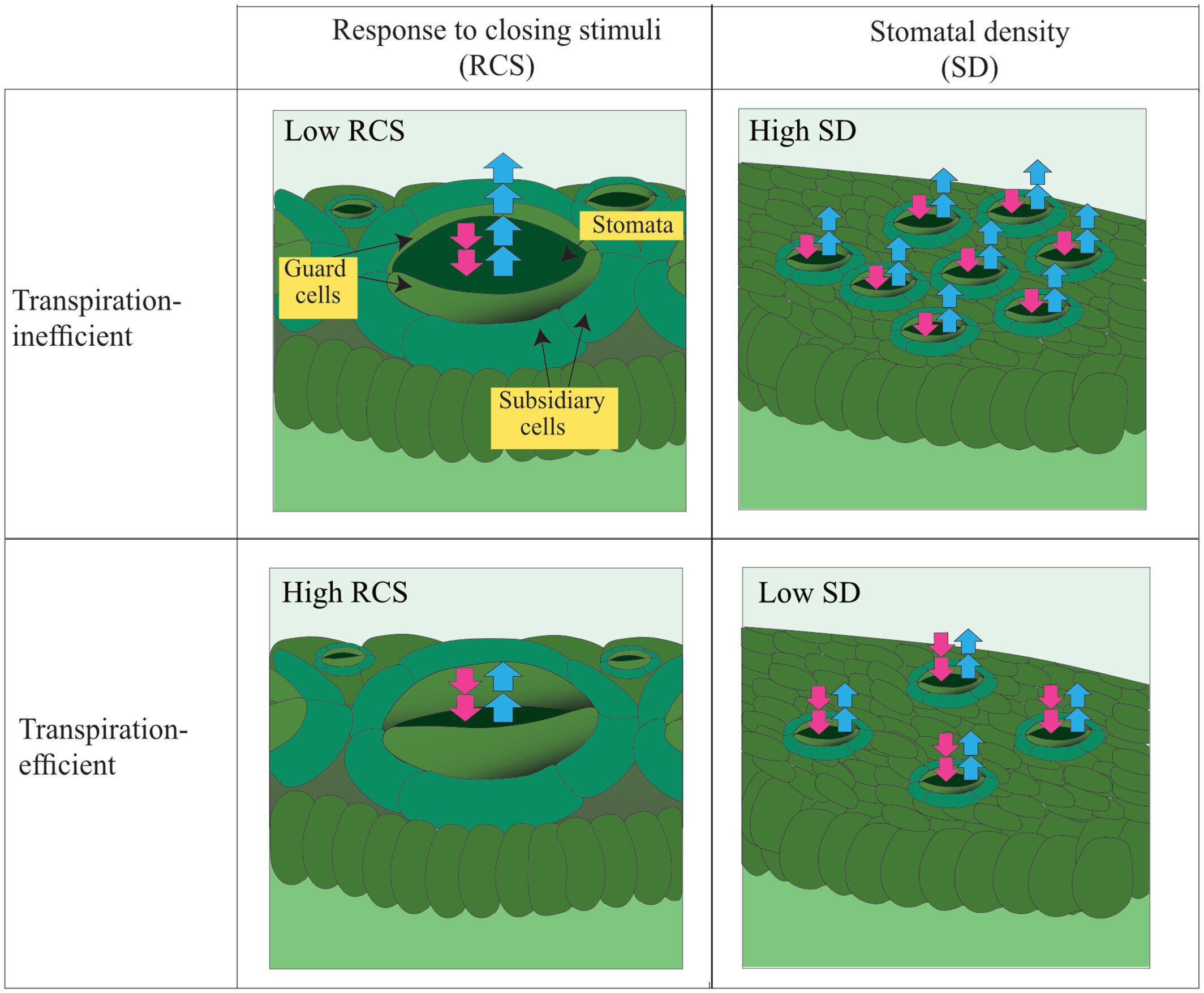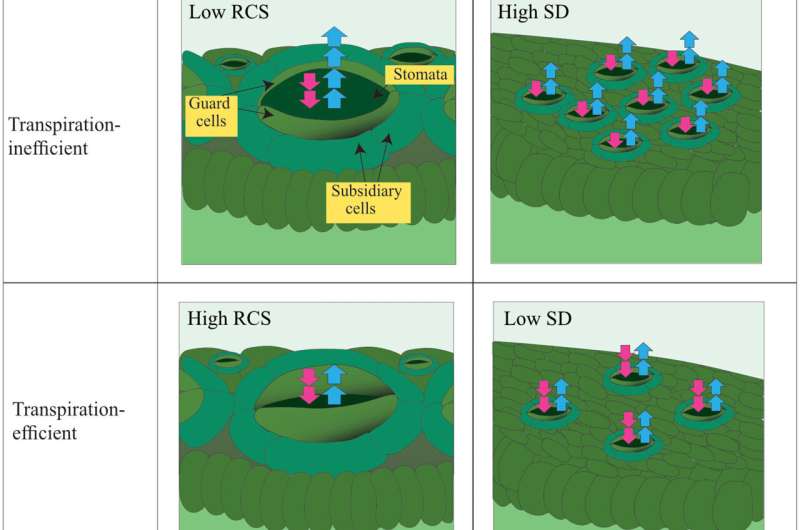
by Luis Manuel Guadarrama-Escobar, James Hunt, Allison Gurung, Pablo J. Zarco-Tejada and Mohammad Pourkheirandish, University of Melbourne

Drought is the most devastating environmental stress that farmers face worldwide. With the added pressures of climate change, drought years have become less predictable, more frequent and more severe.
So not only is water fundamental to producing enough food to feed the global population—predicted to reach 9.7 billion people by 2050—so we need to increase crop yields using less water.
The key to sustainable agriculture could lie in the legacy of wild relatives of essential crops like wheat and barley. These under-exploited genetic treasures harbor stress tolerance mechanisms shaped by generations of natural selection under harsh environments.
Researchers have long recognized wild relatives as a source of stress tolerance in genetic studies, but most of these discoveries happen by chance or have been rare.
There are so many differences between the structure and physiology of commercial crop varieties and their wild relatives that traditional screening methods are inadequate for identifying, analyzing and integrating wild crops into breeding programs.
Our research, published in New Phytologist, establishes a systematic approach using high-throughput and non-invasive imaging techniques to decide which wild lines carry beneficial characteristics for crop improvement and should be considered for breeding, moving away from coincidental discoveries.
Looking beyond the naked eye
Until recently, the best way to determine crop performance in large field experiments was to plant different crop lines and evaluate them based on their appearance and how much grain they produced.
But wild relatives tend to drop their seeds when fully mature, making it hard to judge them by their grain yield so breeders often think twice before working with them.
Innovative remote sensing technologies are now changing how we describe crop performance. It’s like seeing beyond what the naked eye can catch to detect signals from the many light waves plants reflect from the sunlight or emit as fluorescence or heat.
As a form of radiation, heat is emitted at wavelengths beyond what humans can see but can be measured using thermal detectors.
Reflected sunlight provides a wealth of information about how efficiently plants photosynthesize; using sunlight, carbon dioxide and water to produce oxygen and energy in the form of sugar. This can be accurately measured using hyperspectral imaging sensors that collect and process information from across the electromagnetic spectrum in hundreds or thousands of narrow spectral bands.
Although using remote sensing to study plant traits is already popular, we boost it by delving into how efficiently the crop uses water, and combining this information with hyperspectral and thermal imaging technologies.
Understanding the mechanisms that ancient crops use to respond to temperature fluctuation will help us uncover unexplored opportunities for plant breeding and make our research more targeted.
Ultimately the goal is to develop new commercial varieties from the environmentally adapted wild lines, opening a pathway for sustainable agriculture by overcoming the current barrier of determining which wild lines have untapped drought-adaptive characteristics.
This is often tricky to determine because the desirable traits can be different depending on the breeding aim and cultivation location.
Breathing and drinking through the same straw
Plants lose water through a process known as transpiration, which occurs via stomata, the same passages that allow carbon dioxide to enter the leaf surface.
Using the same entry and exit means there is an inevitable trade-off between conserving water and gaining enough carbon to produce healthy grains via photosynthesis.
So our screening technique embraces this trade-off to look for plants capable of enduring extended periods of water shortage, yet can resume healthy growth once rehydrated.
Just like in “Dune,” where people have adapted to handle very dry conditions, plants from desert environments have developed their own ways of dealing with dry conditions.
If we think of human sweating as plant transpiration, plants that are well-adapted to arid conditions have developed multiple mechanisms that allow them to “sweat” less and save water during drought, yet remain less stressed and healthy.
We use the data gathered from hyperspectral and thermal remote sensing techniques to create an image-based transpiration efficiency (iTE) index, a parameter for plant breeding that is relatively easy to interpret.
Using iTE, we can then identify the well-adapted lines that demonstrate such efficient use of water under drought conditions and still can sustain their capacity to resume growth.
Two birds with one stone
Although we developed iTE with wild populations in mind, its application could also extend to cultivated commercial crops.
Transitioning from traditional selection methods that focus purely on yield performance for cultivar selection, the iTE index could be integrated with classical tolerance measurements to make more comprehensive and informed decisions about the best wild lines for breeding.
In collaboration with the Institute for Sustainable Agriculture in Spain, IAS-CSIC, we discovered a strong connection between a positive change in iTE under drought conditions relative to a well-irrigated control, and yield stability in commercial wheat varieties; the greater the increase in iTE, the fewer the yield losses.
Yield stability indicates how well a crop maintains its grain yield under drought compared to normal, well-watered conditions. But there are various reasons why some crops hold up better under drought.
For instance, some plants might keep photosynthesizing effectively, as our research suggests, while others might have deeper roots that access water far below the surface.
The latter might show up as cooler canopies in thermal images because they are able to draw up more water, allowing the plant to keep transpiring, and reducing their temperature.
It is difficult to confirm from a field trial if this transpiration is due to deep roots or if these plants simply keep their pores (stomata) open, regardless of water scarcity. Our research breaks down this complexity to understand precisely how crops achieve yield stability.
By understanding the specific ways plants maintain yield at the end of the season, we can harness the underlying genetics more efficiently.
Crops for the future
Once we have identified promising wild lines, the next step will be to modify them to suit standard agricultural practices through a process known as de novo domestication.
This method accelerates the process humans have used for thousands of years to select and breed better crops. Instead of waiting generations, we use advanced breeding techniques to quickly add the good traits common in domesticated crops directly into the wild, stress-tolerant plants.
These non-transgenic breeding modifications produce crops that are easier to cultivate using standard management practices.
By using hyperspectral remote sensing to identify good candidate wild lines and de novo domestication to make them accessible and desirable to growers, we can revolutionize crop development, adapting plants for the changing climate to meet the growing global food demand.
More information:
Luis M. Guadarrama‐Escobar et al, Back to the future for drought tolerance, New Phytologist (2024). DOI: 10.1111/nph.19619
Provided by
University of Melbourne
Citation:
New sensing techniques can detect drought tolerance in ancient crops, may inform new breeding programs (2024, May 29)
retrieved 30 May 2024
from https://phys.org/news/2024-05-techniques-drought-tolerance-ancient-crops.html
This document is subject to copyright. Apart from any fair dealing for the purpose of private study or research, no
part may be reproduced without the written permission. The content is provided for information purposes only.

